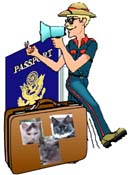| |
|
|
|
| |
It has been 6 years since our last
adventure. Much has happened. Our "family" has shrunk to two people and two
kitties and we have a new home. We decided it was time to start new adventures
- this time with National Geographic/Lindblad on a safari that took us on
both land and sea as we went
"Among the Great
Whales".
We kept a diary of our adventure.
Each part will tell the story of a different day, what we did and what we saw,
in both photos and text.
Day 1. We are back from breakfast - a good
buffet. Our flight yesterday from San Francisco (SFO) to Los Angeles (LAX) was
uneventful but delayed for 2 hours due to the weather. The drive from Point
Arena to San Francisco (SFO) took over 4 hours in sheets of driving rain and
wind. When we got to the San Francisco, many of the streets and intersections
were already flooded due to what the weather people were calling a "monster
storm". But the flight delay gave us time to relax and rest before our arrival
at LAX. Our hotel for the night was the Renaissance Montura LAX. It is quite
comfortable. The Lindblad travel people have chosen
well.
When we arrived at the airport, we were
greeted by a small army of Lindblad people who made sure we had our luggage
tags and ribbons ready and sent us through the check-in and security procedures
prior to boarding the airplane. After we were settled in the departure area,
the Lindblad people appeared again to help us with customs and immigration
documents. They also pointed us to the nearest source of ice
cream.
After another uneventful flight and a
smooth transit through immigration, customs and baggage claim, we met another
group of Lindblad personnel ready to greet us and move our luggage to our
awaiting motor coaches.
The trip from the
airport in La Paz, Mexico to the port was short. As we boarded the ship, we
surrendered our passports and tourist visas to the ship's purser so Lindblad
could do whatever was required to check us through customs wherever we went
ashore. Then we boarded our ship and got settled in our new home.

A couple of weeks before we left home, we had an
Email from one of Jack's college roommates, Dick. In the Email, Dick mentioned
that his daughter was working for Lindblad as third mate on the Sea Lion. We
met Lucinda immediately after boarding. Although we had never met her and
hadn't seen Dick for about 10 years, her friendship was warm and
immediate.
Day 2. Every evening while we are at dinner the
housekeeping staff comes by our room, turns down the beds and leaves a copy of
the itinerary for the next day. That way we not only know how to plan our
activities but, for those of us who are less language enabled, we also get the
names and spelling of the sites we visit.

The plan this
morning was to motor around the Isle Carmen and the Isle Danzante. We were in
the bow at about 9AM watching for mobula rays (a much smaller version of the
manta ray) when the third mate called out that she had seen a whale spout. All
the plans for the morning were then scrapped. Even the "abandon ship drill" was
postponed and we spent the morning chasing giant marine
mammals.
The first whale we saw was a giant
blue whale (a very long whale with a very tiny dorsal fin). It surfaced,
breathed 3-5 times, arched its back, waved its fluke (otherwise known as its
tail) and dove deep to feed for 7-10 minutes. When it needed to breathe, the
process began again, and again, and
again.
Along with the blue whale (the largest
animal on Earth), we saw fin whales. They are much smaller than the blue whales
and blacker in color but they have the same miniature dorsal
fin.
We should also mention the pod of
bottle-nose dolphin who were keeping company with a large number of California
sea lions. The dolphins were bow-riding just below the surface and just ahead
of our ship. They would swim toward us until they felt the bow wave, then they
would swim a quick about-face and ride in front of the
ship.
At one point, the dolphins all swam in
different directions with the last one swimming very fast. On his tail (quite
literally) was a humpback whale. We spent the rest of the morning with the
humpback, watching pectoral fin slapping, fluking and surface rolling - like it
was performing for the cameras. There were digital cameras on "auto" clicking
many frames per second everywhere on deck. All of this before lunch on our
first day !!
After lunch, there was some
"make-up work" to do: briefings about snorkeling, zodiacs, kayaks and our
"abandon-ship drill". Basically, when the klaxon sounds, you stop what you are
doing and listen for instructions while getting your Personal Flotation
Device.
This afternoon, we went out shorkeling
at Honeymoon Cove on Isle Danzante. There are a lot of fish: sergeant majors,
trunkfish, angelfish, sea stars, anemones etc. etc. etc. The water was cold -
about 62 degrees F. For the afternoon activities, we were all transported in
the zodiacs to the beach from where we either snorkeled or kayaked or hiked. It
was sort of like sending the kids off to the beach and giving them a bunch of
toys to play with. We were very well cared for. No matter what eventuality,
Mark, our expedition leader took care of it, often proactively.
Whenever we leave the ship, we take a "cabin
tag" with us. When we go in the water to snorkel, we deposit the tag in a
plastic bin that is left on shore. Out of the water, retrieve the tag. Back
onboard, rehang the tag. It is a good way for the staff to make sure all 59 of
us are safely accounted for.
Our ship has a
physician on board. He joins the groups on shore with his medical supplies and
equipment. Once again, Lindblad is showing their ability to think
proactively. |
For 7 days, we explored on land, on water and
under water. 
Our home for the week was the Sea Lion - a 152
foot long cruise ship. 
Lucinda is the third mate and the daughter of an
old friend. 
Our first whales were a blue whale, a fin whale
and a humpback - all on our first morning.    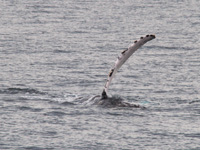 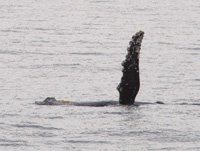      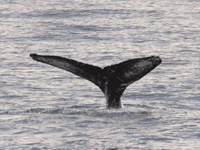
That afternoon, we snorkeled, hiked and kayaked
in Honeymoon Cove on Isle Danzante. 
         |
|
| |

Day 3. This morning we had a gentle wake-up call
at 7AM over the intercom system. We were told that we had arrived at the
California sea lion colony at Los Islotes. Everyone was welcome to come to on
deck in their pajamas to see the glorious sunrise and a rainbow. What magic!
With the sea lions barking loudly, it was hard to tear ourselves away to go to
breakfast.
Very quickly after breakfast, we
were loaded with our snorkel gear into the zodiacs to swim with the sea lions.
The sun was finally breaking through the overcast as we set out. When we were
at the snorkel site, we transferred to a second zodiac from which we slipped
(feet first) into the water. Here the water was warmer - almost 65 degrees F.
There were lots of fish, sergeant majors, damsel fish, jacks, surgeonfish and
angelfish of various types.
After a few
minutes the sea lions came out to play. There were two HUGE bulls (each about
700 pounds and 8 feet long) who were motoring around at the bottom keeping an
eye on the seal pups who were swimming with us. The youngsters would grab our
flippers and our arms with their mouths. They also grabbed each other's tails
(while swimming tight circles) and were generally being playful. At one time,
one of the big males came up, swam past Jan, turned and swam right at her. She
swam away. He also swam to the bottom below another member of our group, turned
with his stomach toward the surface and blew huge bubbles up into that
snorkeler's wet suit.
A group of 2 (sometimes
3) young sea lions were play-fighting under water, grabbing each other while
doing somersaults underwater. As if on cue, they would stop, go to the surface
for a breath, dive and start where they left off. The two big bulls also had an
aggression stand-off underwater. They actually opened their mouths and we could
hear them barking at each other. We had no idea that California sea lions
exhibited the same behaviors under the water as on the land. This was a totally
different encounter with these animals. Even with all our previous experiences
with the marine mammals, this was truly exciting and
memorable.
After a quick change into warm
clothes, we took a zodiac trip around Los Islotes to see the booby colonies.
The blue-footed boobies live at the top of the rock formations and the brown
boobies live just above the nursing sea lions. Below the sea lions, at the
water line are lots of brightly colored crabs. Along with the birds nesting,
there were turkey vultures and double-crested cormorants. Frigate birds and
formations of brown pelicans flew overhead.
Lunch, on the ship, was once again superb. We
had fish, salad, whale tail-shaped tortilla chips and a variety of salad items
(black beans, salsa, avocado etc.). Mexican rice pudding was
dessert.
Then it was on to Isla Espiritu Santo
(Bahia Bonanza) for the afternoon with the "beach toys". We chose to take a
short interpretive hike with Adrien. He was wonderful. The island has 2 very
different ends; the south end is volcanic rock with huge jagged peaks. The
north end is huge, well worn granite boulders (the base rock onto which the
lava and ash were deposited). Evidently in the center of the island is an
earthquake fault and in some ancient movement of the island, the north end
tipped so the granite is up and the volcanic rock is
down.
The plants on the island were spiny or
hairy and usually gray or blue-green. There were a desert lavender, a
nightshade, a relative of the plant that produces capers, lot of agave and a
ton of opuntia, euphorbia and cholla cactus. There was a malva relative and
mesquite. The small purple flowers that we have been encountering are indigo.
While hiking we saw a loggerhead shrike and a Costa's hummingbird among other
birds.
The shells on the miles-long beach were
numerous and varied: oysters 6 inches across, clams that were even larger, huge
scallops, some snails, and conch.
To complete
a glorious day, we had a beach barbecue and campfire for dinner. The food had
been prepared on the ship and brought ashore with camp chairs, wood for the
fire and large metal bins to take the ash and other detritus back with us.
(National Geographic/Lindblad has a wonderful policy of only leaving footprints
and only taking photos.) Before, during and after dinner, the stewards were
going around with trays of drinks while collecting our plates and empty
glasses. There was ferry service by zodiac back to the ship for anyone who
needed to return.
The campfire had music and
stories, marshmallows for roasting, chocolate and crackers for "somemores". It
brought us all back to a quieter time in our lives. |
Our morning at Los Islotes began with sunrise
and sea lions barking.  
First we snorkeled with them... 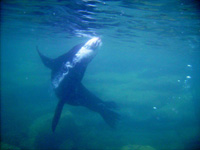 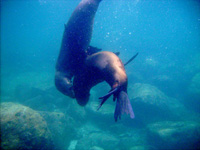  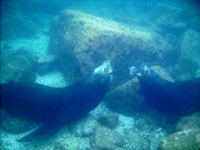   
Then we toured the rookery in our
zodiacs.    
   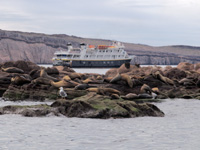     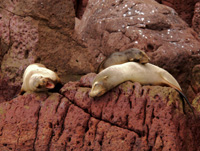 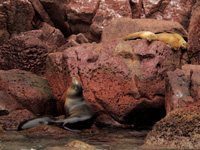  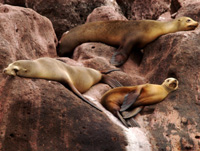  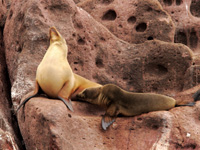 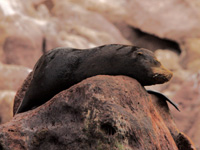   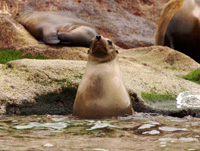
 
After all that excitement, we went ashore for the afternoon and a beach barbecue.
 
     
     |
|
| |

Day 4. Just when you thought that the cruise
couldn't get any more exciting, we awakened to humpback whales. The humpback
whales put on a great show for us, breaching and fin-slapping the water. At one
time, two whales were breaching in unison. One whale actually breached about
100 yards from our port bow. We spent the morning motoring slowly and gently
toward Gorda Bank and Cabo San Lucas. Then our plans for the next 24+ hours
changed and Lindblad showed their unmatched ability to take care of us and
entertain us in a seemingly ever-changing
situation.
At about 5:00 this morning, the
crew noticed that one of the ship's engines was not working properly. While the
ship could run well on one engine, the weather report was for a wind storm on
the Pacific side of Cabo San Lucas with 10-12 foot swells. With one engine, the
12 hour crossing around Land's End would have taken 24 hours and with the wind
and seas, it was decided that right after lunch we would all leave the ship in
Cabo San Lucas.
Entering the harbor at Cabo
San Lucas was like driving through the downtown area of a city. There were
ships and boats everywhere, all driving like maniacs. We asked our captain how
he manages to deal with the traffic and he said that he goes steadily and
slowly. Docking in Cabo was fun to watch. All the hands and the naturalists
have jobs - line handlers or zodiac tug boat drivers or "parking assistants".
The captain put the nose of our ship almost against the dock and he fires the
thrusters in the bow and the zodiacs nudge the stern into place. It was amazing
- made even more so when a fishing boat cut in front of us as we were in our
final parking maneuvers.
After docking, our
overnight bags were collected and we walked ashore, abandoning the Sea Lion.
Although it was only a couple of blocks, whenever there was a corner or a turn
for us to make, a member of the crew or a naturalist was there to make sure we
didn't get lost. We then boarded our motor coaches (that we named Sea Slug and
Sea Snail) for the trip to La Paz for the night. There were some huge yachts in
Cabo, street vendors along the dock and people everywhere. There was a truck
parked in the middle of the street with no driver in view. Just like every
other city. En route, we stopped at the artist community of Todos Santos to
stretch our legs. It is a great town that we would love to visit
again.
It took several hours to reach La Paz.
Along the way, we watched humpback and California gray whales spouting just off
shore. Our room at Hotel Los Arcos was large and comfortable. There is a center
courtyard with a pool and beautiful tilework everywhere. After we had time to
clean up, we were treated to a Ballet Folklorico performance in the Patio
Bugambilias courtyard. The costumes were gorgeous and the dancing was
outstanding. The corps de ballet are students at a local university. Dinner was
the most extravagant buffet that we have ever seen. The buffet table must have
been 50 feet long. It contained every Mexican dish that we had ever heard about
and lots of American dishes as well. After dinner, we each received a voucher
for ice cream at La Fuente (the ice cream shoppe across the street from where
we boarded the Sea Lion a few days before). We walked down to La Fuente and
back along La Paz's beautiful harborside promenade. We stopped at the bronze
statue of the Old Man and the Sea and watched a great blue heron
fishing.

Our Three Kitty Kompany motto is "Life if an
adventure - DEAL WITH IT". One of our fellow travelers came up with a
modification, "Life is an adventure - GET OVER IT". |
Just as yesterday began with sea lions, today
began with humpback whales giving us quite a show. 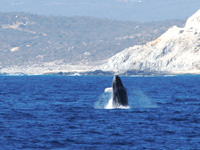    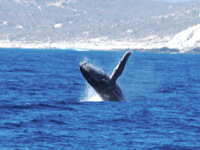 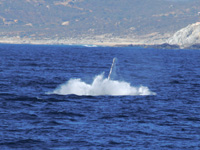 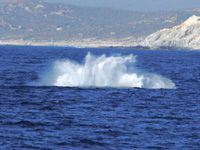       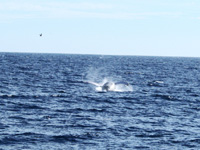 
After that show, we sailed into Cabo San
Lucas.          
Then it was all aboard the Sea Slug and the Sea
Snail for overland travel to Todos Santos and ...   
on to La Paz for the night.
      |
|
| |
Day 5. After breakfast at the hotel cafe, we
once again boarded the Sea Snail and the Sea Slug for the trip to Puerto Adolfo
Lopez Mateos. Our entourage included not only 59 passengers and 2 drivers but
also 5 naturalists, a National Geographic Expert, the physician, the
videographer, the expedition leader and the hotel manager. While en route, we
were entertained with a plant lecture and bird interpretation from the
naturalists. We were also well fed while we traveled. There were coolers of
drinks brought out from under the bus whenever we stopped and snacks occupying
two seats inside each bus. We named our hotel manager "She who travels with
snacks". We had granola bars, oreo cookies, animal crackers, chips, flavored
nuts of various types and more. With a stop just outside La Paz at an
agricultural check point (Yes, the Federales have weapons and yes, they might
want to enter the bus.) and a rest stop at a small village, we arrived at
Ballena Gris restaurant in time for lunch. It took a few minutes on the narrow
streets in the tiny town for the ballet of motor coaches to get us on the right
side of the street to disembark in front of the restaurant. Lunch was lobster
tail, fried fish, salad, rice and tortillas. The lobster was very fresh, having
been harvested from the sea specifically for our
lunch.
After lunch we walked through town to
the harbor where we boarded pangas (Mexican fishing boats) for about 2 hours of
whale watching at the lagoons of Magdalena Bay. It was windy, choppy, quite
cool and wet. We saw several mother and calf
pairs.
After whale-watching things slowed down
considerably as the Sea Lion was behind schedule. So once again we ate. Before
boarding our trusty steeds, we had great trail mix (with chocolate), more soft
drinks, Baby Belle cheese and caramels made from goat milk. Our land vehicles
drove about an hour and a half to San Carlos where the Sea Lion was still not
docked so we ate and we drank and we ate and we drank at the Hotel Alcatraz.
Drinks were margaritas and food was traditional tapas. We were frozen, wet,
dirty and disheveled but we laughed harder than we had in years as we plotted
to take over the ship dressed as
pirates.
After a couple of hours, we were done
"bellying our way through Baja" on what our expedition leader called the
Landblad/National Geographic "waistline expansion program" and we were motored
across the street and down the pier (backwards) to the ship. We were greeted by
the captain and a steward who had hot towels for us all. We returned our cabin
tags to the board and had yet another meal. Dinner was hot soup, chicken Caesar
salad, rolls and chocolate chunk cookies. As we ate, the ship left the dock,
sailed into the lagoon and dropped the anchor for the night still running on
only one engine. |
We left La Paz right after breakfast to arrive
in Lopez Mateos for lunch.
 
After lunch we walked through town to the
harbor.   
From there we went whale watching from small
fishing boats called pangas.    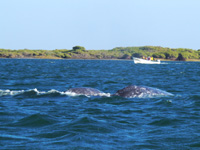   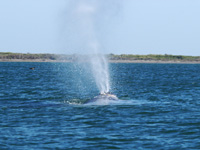 |
|
| |

Day 6. Today we sailed through the very narrow,
very shallow Hull Canal from the south end of Bahia Magdalena to the north.
During breakfast, we took aboard a local pilot to steer us through the canal.
Hull Canal is the only part of the bay that has been dredged - many years ago -
and it is ankle deep on a heron for yards and yards from shore and then in the
middle of the canal, just a few yards from the wading heron, it is deep enough
for our ship. Every year the pilot sounds the canal and sets the buoys for
navigation.
Along the route that took several
hours, we saw the entire complement of shore and sea birds. There were herons
(great blue, tricolor and green), egrets (great and snowy), common loons,
double-crested cormorants, brown pelicans, western gulls, Brants (geese),
wimbrel, godwit and frigate birds. We also saw a coyote on the barrier island
and 3 burros. Before breakfast, just after sunrise, we saw 2 lines of
cormorants flying north, one line on each side of the ship. The lines extended
as far as we could see in both directions. There must have been over 1000
birds. It was very reminiscent of the migrations of wildebeest and zebra that
we saw in the Masai Mara over 20 years ago. Along with the birds, there were
bow-riding bottle-nose dolphins that we could actually hear whistling as they
were riding.
After lunch, we loaded the
zodiacs to find the gray whales. The whales are very late this year arriving
from their northern feeding grounds so there was only a single mother/calf pair
for us to watch. After whale watching, we went beach combing on Isle Magdalena,
the barrier island that protects the lagoons from the Pacific Ocean. The beach
was awesome and the dunes are as good as any we've seen. The island is
surrounded mostly by mangrove except where the shifting sand kills the mangrove
and the dunes then take over. There were clam, scallop and auger shells
everywhere. We even found a plover of some sort - about 7 inches long - larger
than the Western Snowy Plovers we are used to and this bird has yellow
legs.
Back on board this evening, we enjoyed
local musicians and dinner followed by the video made on our trip by Carlos,
our underwater specialist. |
Back on the Sea Lion, we sailed gently down the
calm waters of the Hull Canal watching birds, dolphins and an occasional
whale.  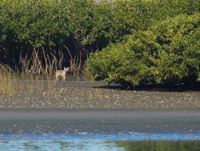  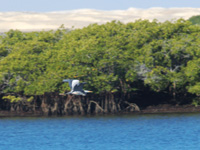   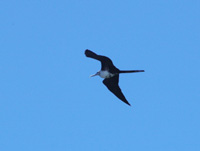 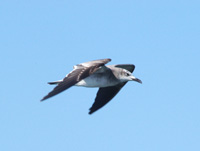  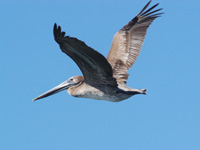 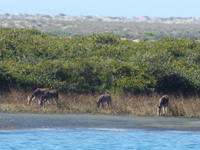 
After arriving at the north end of Bahia
Magdalena, the zodiacs once again were put into the water for more whale
watching.    The whale watching was followed by beach combing
on the magnificent white sand beach.      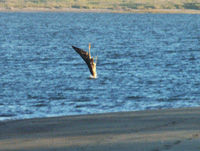 |
|
| |

Day 7. Our wake-up call on the intercom was
early this morning as we had opted for a "sunrise" zodiac cruise (as opposed to
the "civilized" zodiac cruise after breakfast. Although it was chilly, it was a
gorgeous sunrise and a great whale-watching trip. We saw many whales and
mother/calf pairs. At one point, a calf started towards our zodiac and its
mother came across at "warp speed" to cut it off so it couldn't get too close.
One whale swam directly towards us and dove just a few feet from our zodiac.
Because the calves are still very young (most less than a week old), that was
our closest encounter. That was close enough for these seemingly gentle
giants.
After all whale watchers were safely
on board, we slowly made our way back out of the channel and once again into
the southern end of the lagoon. Our escorts were several whales with very small
calves and 3 or 4 sets of bow-riding bottle-nose dolphins. Late in the
afternoon we anchored again just outside San Carlos and mounted the zodiacs to
cross to Isla Magdalena where we walked the 1/4 to 1/2 mile across the sand
dune field to the Pacific ocean and Sand Dollar Beach. It was pristine and
peaceful and beautiful. It was a perfect way to finish the trip. The sand
dollars were 4-6 inches in diameter and some of them still had their "fur"
coatings, having been alive in the ocean just hours or maybe days before. On
the beach, there were also bones from dolphins, sea lions and whale calves. In
the dunes, there were several shell middens to explore, left by occupants of
years ago.
Dinner was special as it was our
last together. Our time in the Sea Snail and the Sea Slug bonded many members
of the group. We laughed during dinner until we cried. We then packed, checked
out with the purser and went to bed.

Days 8 & 9. The anchor was pulled up at 4AM
this morning. The intercom had the "wake-up call" at 5AM. After breakfast, we
disembarked, hugged the naturalists, the expedition leader, the captain and the
crew and said "farewell" to all at the dock in San Carlos. There we once again
boarded the Sea Snail and the Sea Slug for the 3 hour overland trip to the
airport in La Paz. En route, we got to watch the sun rise. It was beautiful and
red.
Our flight was uneventful and passage
through immigration and customs back into the US was slow and crowded but
uneventful. After another night at the Renaissance Montura LAX, we flew to San
Francisco and drove home to Point Arena.
Most of Baja, Mexico is very desolate, very
rural, and very dry. It makes our tiny city of Point Arena (with a population
well under 1000) look like downtown Manhattan. The ability of National
Geographic/Lindblad to arrange hotel rooms, extravagant buffets, ice cream,
lobster lunches, entertainment, snacks and drinks on less than 12 hour notice
says a lot for their ability, their in-country contacts and the respect that
they must have from their partners, vendors and suppliers. We enjoy traveling
the less trodden paths. The sense of comfort that you get with the knowledge
that your travel arrangements will be well completed (and you will be well
cared for) can't be easily described. We will definitely travel with National
Geographic/Lindblad again. For anyone who wishes further information, please
contact Wookie at our 3kitty.org. Email address.
The
End |
After a sunrise whale watching trip, we quietly
and gently sailed south again towards the port of San Carlos. Our escorts were
dolphins, birds and whales.              
     
Our last afternoon on the Sea Lion was spent
exploring a beach and sand dunes that seemed virtually untouched by
mankind.                   |
|
| |
|
|
|
